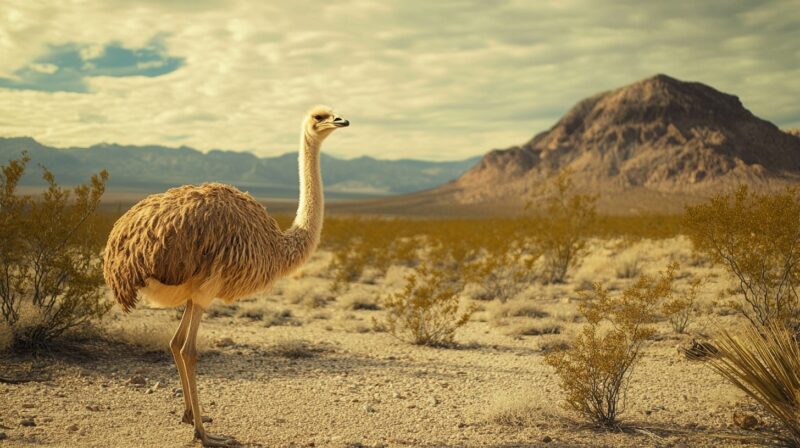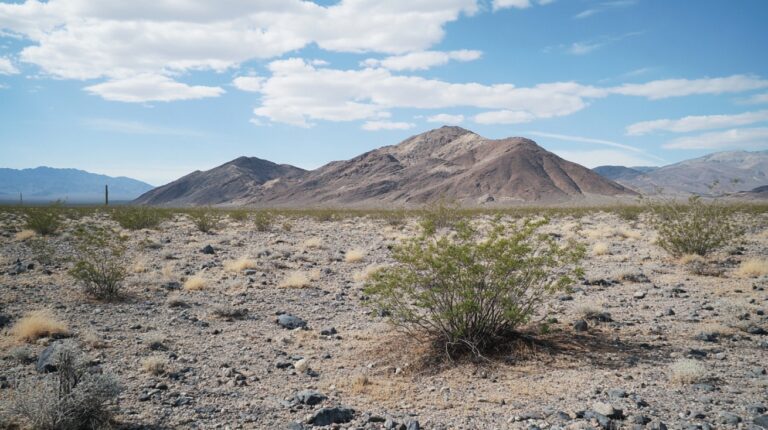Last year, I went on a trip to the desert with a couple of my friends for one evening. I loved it. Earlier this year, I thought about how cool it would be to spend a couple of days in the desert, and I decided to do it on my own. You can’t expect many people to follow you on this kind of trip, obligations, right?
I must say that spending a couple of nights in the desert, relatively close to Ivanpah Solar Power Facility, was an eye-opener. It must be said I never thought there were so many desert animals living there.
I decided to write about desert animals we can find in Nevada.
Let’s talk about it.
1. Desert Bighorn Sheep
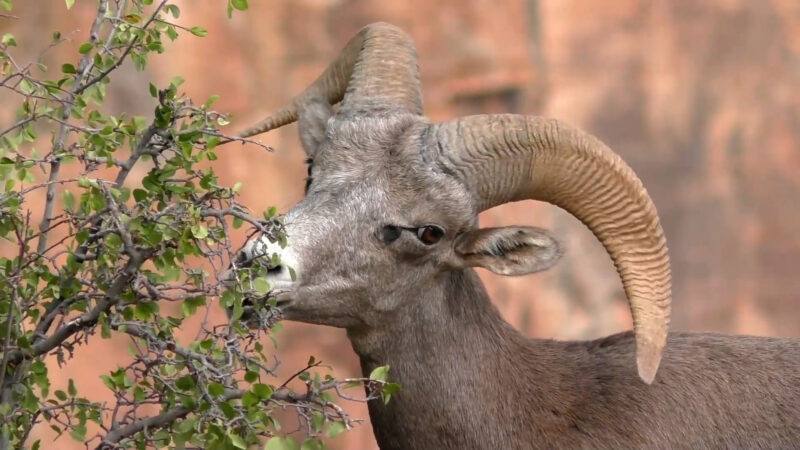
- Characteristics:
- Size: Large, muscular, with strong hooves for climbing.
- Diet: Shrubs, grasses, cacti.
- Adaptation: Capable of enduring long periods without direct water sources, keen eyesight for spotting predators.
The first among the desert animals is the desert bighorn sheep, Nevada’s state mammal, well-known for its impressive climbing abilities and distinctive curled horns, which aid in navigating the rocky terrain of Nevada’s deserts.
These sheep are experts at conserving water, often going without it for extended periods. That allows them to survive in arid regions where other desert animals might struggle.
Their diets primarily consist of shrubs, grasses, and cacti, which provide them with essential hydration and nutrients.
2. Mountain Lion
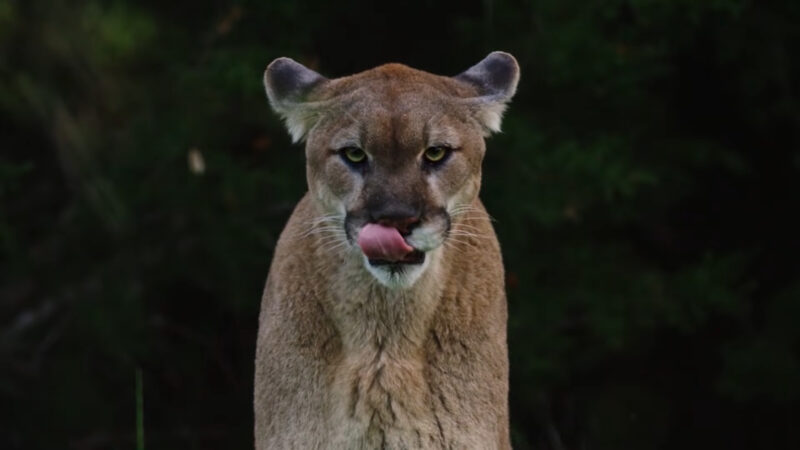
- Characteristics:
- Physical Build: Strong limbs, sharp claws, muscular frame.
- Hunting Behavior: Solitary predator, hunts at dawn and dusk.
- Diet: Primarily deer, smaller mammals like hares, and sometimes reptiles.
Mountain lions, known as cougars, are the top predators in Nevada’s desert ecosystems.
With powerful limbs, sharp claws, and a muscular build, these cats are skilled hunters capable of taking down prey much larger than themselves.
Their solitary nature and vast territorial ranges allow them to avoid competition and control prey populations, playing an essential role in the ecosystem’s health.
They are active primarily at dusk and dawn, which helps them avoid the desert’s intense midday heat.
3. Black-Tailed Jackrabbit
- Characteristics:
- Size: Medium-sized with long legs and large ears.
- Adaptation: Ears that regulate body heat.
- Diet: Grasses, shrubs, cactus pads.
The black-tailed jackrabbit, a common sight in Nevada’s deserts, is perfectly adapted to the harsh climate.
This hare species has large, sensitive ears that help regulate body temperature, releasing excess heat to stay cool.
Their excellent speed and agility help them evade predators in the open landscape.
Jackrabbits primarily feed on grasses, shrubs, and cactus pads, allowing them to thrive in areas where food resources are limited.
4. Coyote
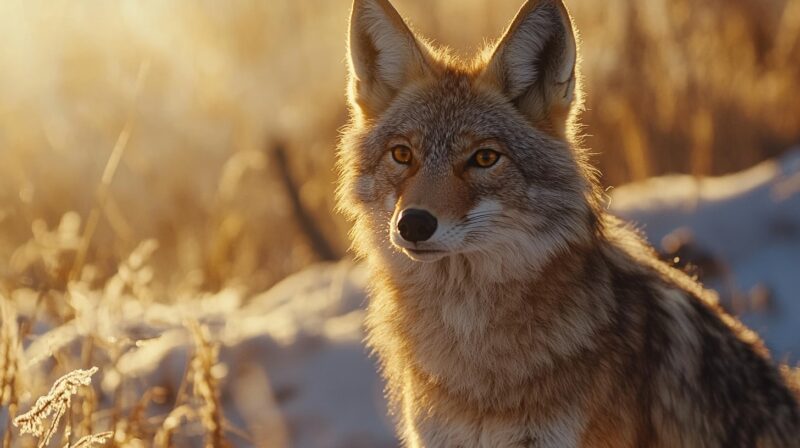
- Characteristics:
- Size: Medium-sized, slender build.
- Adaptation: Opportunistic diet, adaptable hunting methods.
- Diet: Small mammals, reptiles, fruits, and urban food sources.
Coyotes are known for their adaptability, thriving not only in Nevada’s deserts but also in urban environments.
These intelligent animals have a highly varied diet which includes other desert animals, reptiles, fruits, and even human food waste when available.
Coyotes’ adaptable hunting techniques and social structures, including both solitary and pack behavior, make them incredibly versatile in managing the challenges of desert life.
5. Bobcat
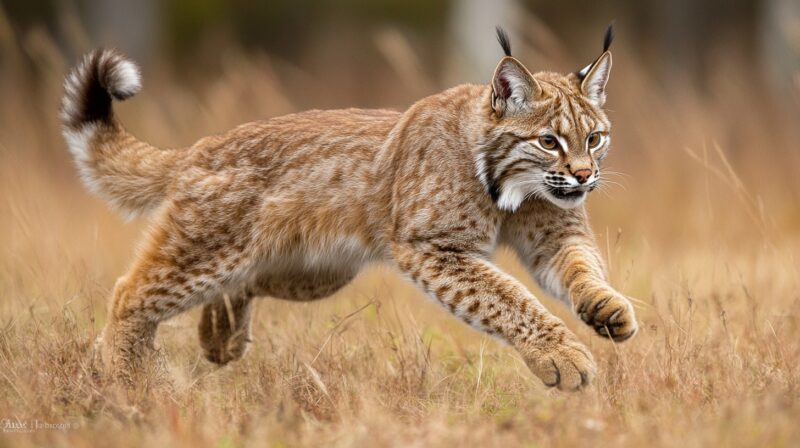
- Characteristics:
- Size: Medium-sized, muscular.
- Adaptation: Camouflaged coat for blending with rocky terrain.
- Diet: Small mammals, birds, and occasionally reptiles.
Bobcats are elusive desert predators known for their solitary nature and expert hunting skills.
These medium-sized cats are incredibly agile and well-camouflaged, often lying in wait to ambush prey.
Their fur pattern helps them blend into rocky, shrub-dense environments, making them nearly invisible to both prey and potential threats.
Bobcats primarily hunt small mammals and birds, helping control populations of desert rodents.
6. Desert Cottontail
- Characteristics:
- Size: Small, with a distinctive cotton-like tail.
- Adaptation: Efficient hydration from food sources, burrow-hiding for predator evasion.
- Diet: Grasses, shrubs, cactus pads.
The desert cottontail is a small, agile rabbit adapted to thrive in Nevada’s arid environments.
Known for its speed and sharp instincts, the cottontail often seeks refuge in burrows or dense shrubs to escape predators.
Its diet includes grasses, shrubs, and even cacti, which help it meet hydration needs.
Desert cottontails are crepuscular, meaning they’re most active during dawn and dusk, avoiding the day’s extreme heat.
7. Kit Fox
- Characteristics:
- Size: Smallest fox species in North America, with large ears.
- Adaptation: Nocturnal habits, heat-regulating ears, burrowing.
- Diet: Small mammals, birds, insects, fruits.
The kit fox, the smallest fox species in North America, is perfectly suited for desert life.
With large ears that aid in dissipating heat and enhance its acute sense of hearing, the kit fox excels at finding food and shelter in Nevada’s deserts.
It feeds on small mammals, birds, insects, and even fruits when available.
Primarily nocturnal, kit foxes avoid the daytime heat by hunting at night and resting in cool burrows.
8. Ringtail
- Characteristics:
- Size: Small, with a long ringed tail.
- Adaptation: Agile climber with rotating hind limbs.
- Diet: Small mammals, insects, fruits.
The ringtail, a nocturnal carnivore known for its agility and distinctive ringed tail, is a rare sight in Nevada’s deserts.
These small mammals are highly adept at climbing and can easily scale cliffs and rocky outcrops.
Ringtails are omnivores, primarily feeding on small mammals, insects, and fruits.
Their ability to rotate their hind legs 180 degrees aids their agility, making them excellent hunters and escape artists in rocky desert terrains.
9. Antelope
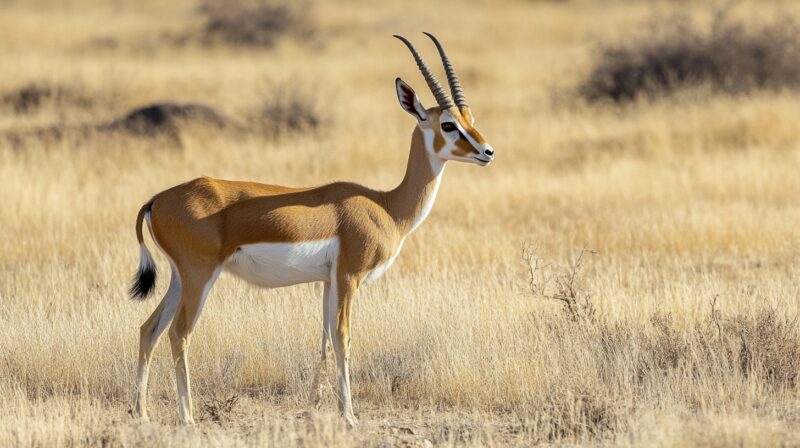
- Characteristics:
- Size: Medium, with long legs built for speed.
- Adaptation: High-speed running, large lungs for endurance.
- Diet: Grasses, shrubs, herbs.
Antelopes, particularly pronghorns, are unique desert dwellers renowned for their speed and endurance.
Known as one of the fastest mammals in North America, pronghorns can reach speeds up to 60 miles per hour, a crucial adaptation for evading predators in open desert landscapes.
They possess large lungs and heart capacity, supporting their impressive endurance.
Pronghorns feed on grasses, shrubs, and herbs, surviving long periods without water by absorbing moisture from their food.
10. Greater Roadrunner
- Characteristics:
- Size: Medium, with strong legs for ground movement.
- Adaptation: Fast runner, skilled predator.
- Diet: Scorpions, snakes, insects.
The greater roadrunner is a bird known for its impressive speed and predatory abilities, often preying on scorpions, snakes, and insects in the Nevada desert.
Unlike many birds, the roadrunner spends most of its time on the ground, relying on its fast, strong legs to chase down prey.
Roadrunners are also highly adaptable and can endure the arid environment with minimal water intake, obtaining most of their hydration from their diet.
11. Burrowing Owl
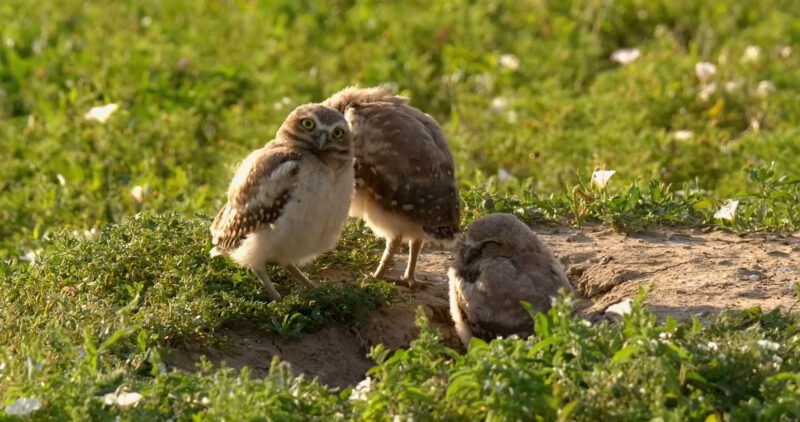
- Characteristics:
- Size: Small, long legs.
- Adaptation: Daytime hunting, burrow nesting.
- Diet: Small mammals, insects, reptiles.
The burrowing owl is an owl species that nests underground, a rare trait among owls.
These small, slender birds can be found in open desert landscapes and often use abandoned burrows dug by prairie dogs or other desert animals.
Burrowing owls are active during the day and hunt small mammals, insects, and occasionally small reptiles. Their underground burrows protect them from predators and the harsh desert climate.
12. Prairie Falcon
- Characteristics:
- Size: Medium, with broad wings.
- Adaptation: Swift flight, exceptional eyesight.
- Diet: Small mammals, birds, reptiles.
Prairie falcons are swift predators known for their agile flight and hunting skills in open desert skies.
They have keen eyesight and sharp talons, which make them formidable hunters. Prairie falcons primarily feed on small mammals, birds, and occasionally reptiles.
They are skilled at catching prey in mid-air and rely on their speed to swoop down on targets from great heights.
13. Bald Eagle
- Characteristics:
- Size: Large, with broad wingspan.
- Adaptation: Strong beak and talons, excellent vision.
- Diet: Fish, small mammals, birds.
Although often associated with coastal or forested regions, the bald eagle is also found near water sources in Nevada’s desert areas.
These majestic birds are highly adaptable and are drawn to regions with ample fish and small mammals.
Their large wingspan allows them to soar for long distances, scanning for prey.
Bald eagles are crucial to the desert ecosystem as top predators, keeping populations of smaller desert animals in check.
14. American Kestrel
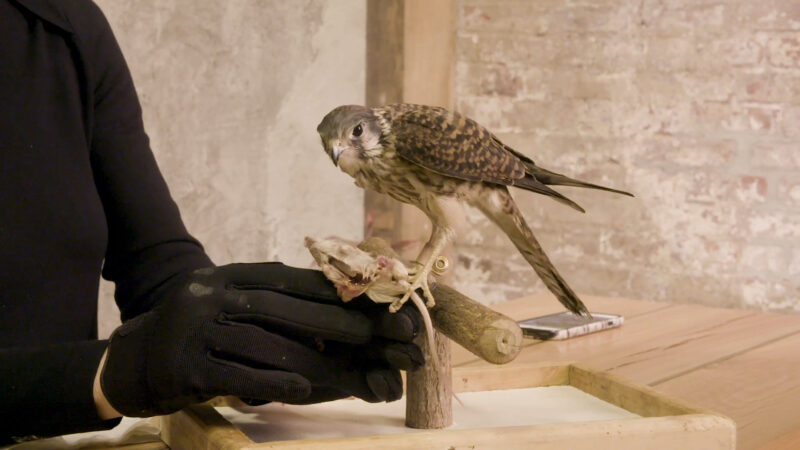
- Characteristics:
- Size: Small, with vibrant plumage.
- Adaptation: Hovering ability, sharp vision.
- Diet: Insects, small birds, rodents.
The American kestrel is the smallest falcon in North America, yet it is fierce and adept at hunting.
This bird of prey is often sighted on power lines in Nevada’s deserts, watching for smaller desert animals below. Kestrels have sharp eyesight and can hover in the air while hunting.
Their diet includes insects, small birds, and rodents, making them adaptable hunters in diverse environments.
15. Ferruginous Hawk
- Characteristics:
- Size: Largest hawk species in North America.
- Adaptation: Powerful talons, sharp eyesight.
- Diet: Rabbits, rodents, snakes.
As the largest hawk species in North America, the ferruginous hawk is a formidable hunter in Nevada’s deserts.
These hawks have broad wings and powerful talons, enabling them to capture a wide range of prey, including:
- Rabbits
- Rodents
- Snakes
They are primarily found in open, arid landscapes where they can use their excellent vision to spot prey from high in the sky.
16. Mountain Bluebird
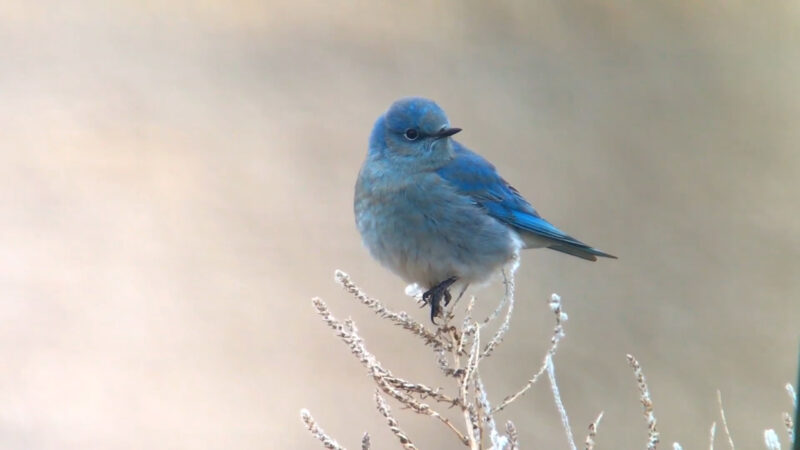
- Characteristics:
- Size: Small, with vibrant blue feathers.
- Adaptation: Feeds on insects and berries.
- Diet: Insects, berries.
Nevada’s state bird, the mountain bluebird, is celebrated for its vibrant blue plumage and graceful flight.
These birds are often found perched on shrubs or small trees in open desert areas.
Mountain bluebirds feed primarily on insects and berries, adapting well to the sparse vegetation of the desert.
Their striking coloration helps them stand out as a Nevada icon.
17. Desert Tortoise
- Characteristics:
- Size: Medium, with a hard shell.
- Adaptation: Burrowing and drought tolerance.
- Diet: Desert plants, grasses, cacti.
The desert tortoise is an iconic species in Nevada, known for its long lifespan and remarkable adaptations to drought.
It spends most of its life underground in burrows, conserving energy and avoiding the desert heat.
The tortoise can go months without water, getting necessary hydration from plants.
A slow-moving reptile plays a crucial role in the desert ecosystem by helping disperse seeds and promoting vegetation growth.
18. Gila Monster
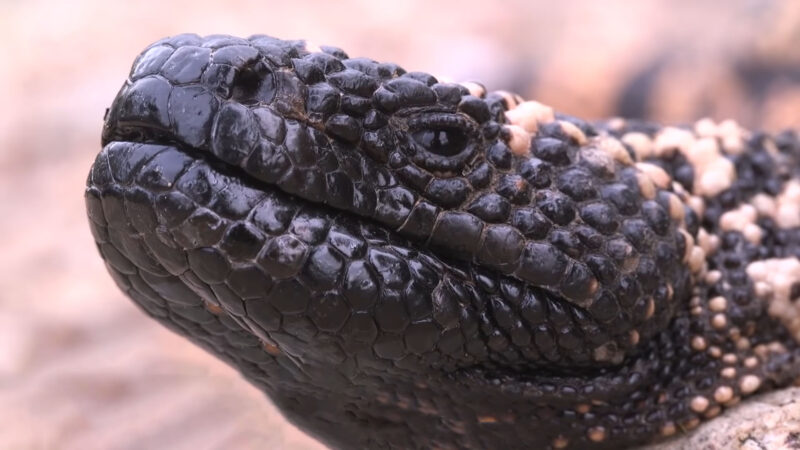
- Characteristics:
- Size: Medium, with thick, bead-like skin.
- Adaptation: Venomous bite, burrow-dwelling.
- Diet: Small mammals, birds, eggs.
The Gila monster, a venomous lizard native to Nevada’s deserts, is one of the few venomous lizards in North America.
It spends most of its time underground, emerging primarily to feed. This slow-moving predator feeds on small mammals, birds, and eggs.
The Gila monster’s venom serves as both a defense mechanism and a hunting tool, making it a unique addition to Nevada’s wildlife.
19. Mojave Rattlesnake
- Characteristics:
- Size: Medium, with distinctive rattle.
- Adaptation: Camouflage and potent venom.
- Diet: Small mammals, birds, reptiles.
The Mojave rattlesnake, which lives, well, in Mojave Desert, is well-camouflaged in Nevada’s desert sands, blends in seamlessly with its surroundings.
Known for its potent venom, this snake is a skilled predator that feeds on small mammals, birds, and reptiles.
The rattlesnake’s distinctive rattlesnake warns predators and humans of its presence, showcasing its highly evolved defense mechanism.
20. Sidewinder
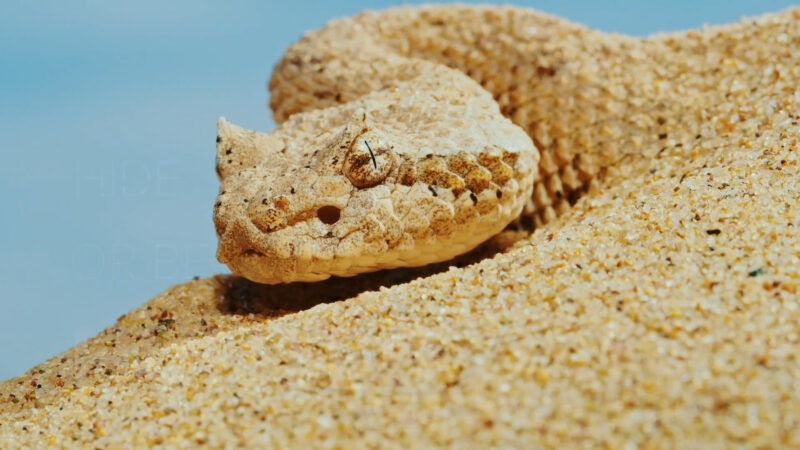
- Characteristics:
- Size: Small to medium, with eye “horns.”
- Adaptation: Sidewinding motion for desert travel.
- Diet: Small mammals, lizards.
The sidewinder, one the best-known desert animals, is a snake recognized for its sideways movement, an adaptation that allows it to navigate the desert sands efficiently.
This snake is also known for its distinct horns above its eyes, which protect it from sand.
Sidewinders are primarily nocturnal and hunt small mammals and lizards, using their ambush techniques to capture prey.
21. Chuckwalla
- Characteristics:
- Size: Large, with loose skin.
- Adaptation: Inflates body to evade predators in crevices.
- Diet: Desert plants, flowers, fruits.
The chuckwalla is a large, herbivorous lizard commonly found in rocky habitats across Nevada’s deserts.
Chuckwallas have loose skin and can inflate their bodies to wedge themselves into tight crevices, evading predators.
They are primarily herbivores, feeding on desert plants, flowers, and fruits. Their adaptation to rocky terrains helps them avoid extreme heat and predators.
22. Collared Lizard
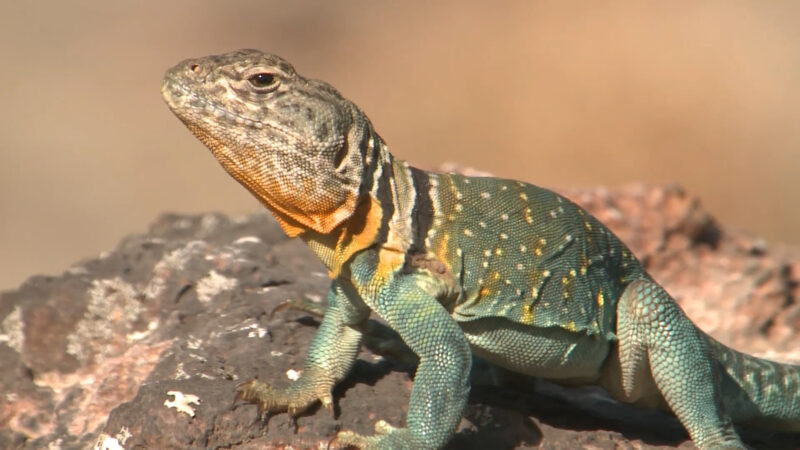
- Characteristics:
- Size: Medium, with collared markings.
- Adaptation: Bipedal running ability.
- Diet: Insects, small mammals, lizards.
Collared lizards are agile predators with distinctive black markings around their necks, giving them a “collared” appearance.
These lizards are swift movers and can even run on two legs to escape threats.
They feed on insects, small mammals, and occasionally other lizards, making them efficient hunters.
23. Leopard Lizard
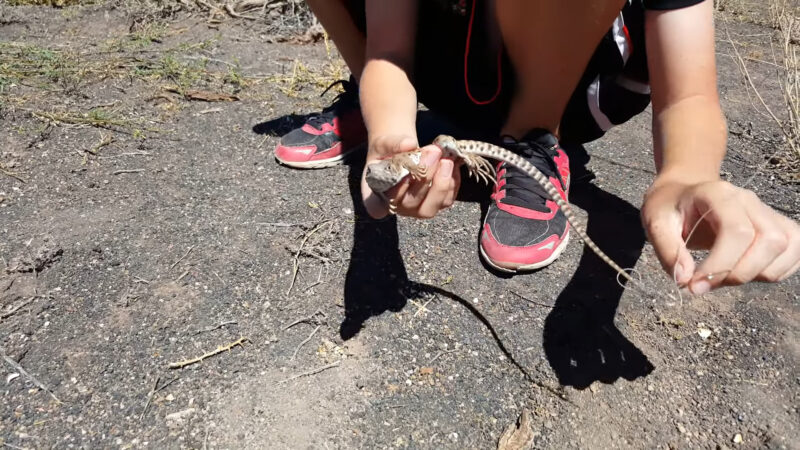
- Characteristics:
- Size: Medium, with spotted body.
- Adaptation: Camouflage for predator evasion.
- Diet: Insects, small reptiles, lizards.
The leopard lizard is named for its distinctive spotted pattern, which provides excellent camouflage in desert terrain.
These are agile and quick, primarily feeding on insects, small reptiles, and sometimes other lizards.
Their ability to blend into the rocky and sandy environment helps them avoid predators and capture prey efficiently.
24. Great Basin Spadefoot Toad
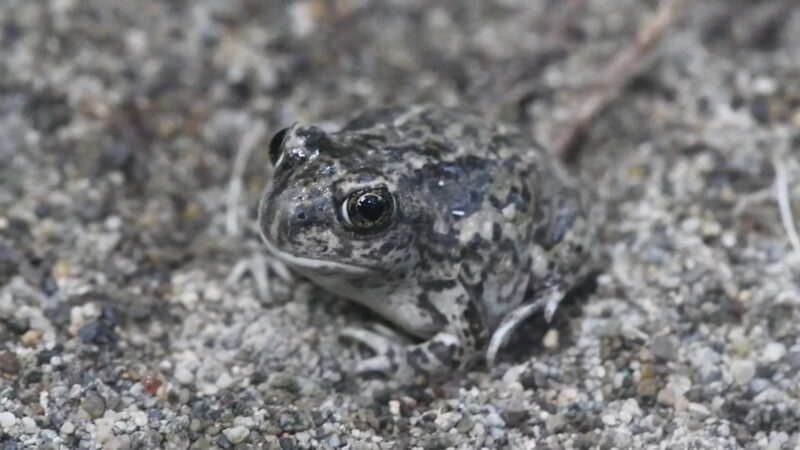
- Characteristics:
- Size: Small, with spade-like hind feet.
- Adaptation: Burrowing and rainfall emergence.
- Diet: Insects.
Adapted to the desert’s dry conditions, the Great Basin spadefoot toad emerges only after rainfall, spending much of its life underground.
Great Basin spadefoot toads are small and possess spade-like structures on their hind feet, aiding in digging.
Their diet consists primarily of insects, which they consume in large quantities during their brief active periods after rainstorms.
25. Western Toad
- Characteristics:
- Size: Large, with rough skin.
- Adaptation: Burrowing for moisture retention.
- Diet: Insects, small invertebrates.
The Western toad is often found near temporary water sources in the desert.
Western Toad is adaptable and can survive in arid conditions by remaining close to water and burrowing into the soil during dry periods.
Its diet consists of insects, small invertebrates, and occasional plant material, making them versatile feeders.
26. Desert Pupfish
- Characteristics:
- Size: Small.
- Adaptation: Tolerance for saline and warm water.
- Diet: Algae, invertebrates.
The desert pupfish is a unique species that thrives in isolated desert springs and pools, demonstrating resilience in highly saline and warm waters.
This small fish has adapted to survive extreme conditions and temperature fluctuations.
Desert pupfish feed on algae, small invertebrates, and detritus, contributing to the ecosystem by keeping algae populations in check.
27. Lahontan Cutthroat Trout
- Characteristics:
- Size: Medium to large.
- Adaptation: Cold-water survival.
- Diet: Insects, smaller fish, crustaceans.
Nevada’s state fish, the Lahontan cutthroat trout, inhabits specific freshwater streams and lakes.
Lahontan Cutthroat Trout has adapted to cold, high-altitude environments and is highly valued in Nevada’s waterways.
Its diet includes insects, smaller fish, and crustaceans, making it a top predator in its aquatic ecosystem.
28. Moapa Dace
- Characteristics:
- Size: Small.
- Adaptation: Warm stream habitat.
- Diet: Algae, invertebrates, plant matter.
The Moapa dace is an endangered fish endemic to warm desert streams in Nevada.
This small fish has adapted to fluctuating water conditions and survives by feeding on algae, aquatic invertebrates, and plant matter.
The Moapa dace is a key species in Nevada’s desert waterways, indicating the health of these fragile ecosystems.
29. Giant Desert Hairy Scorpion
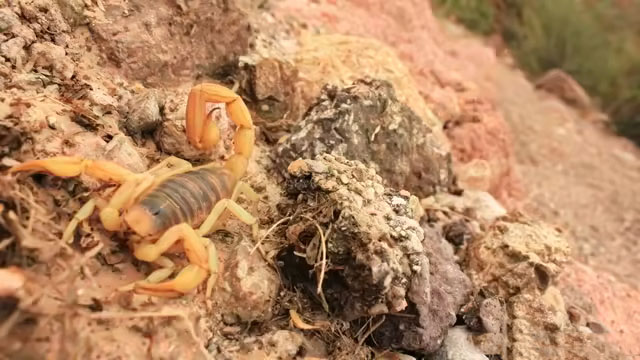
- Characteristics:
- Size: Large.
- Adaptation: Venomous, nocturnal.
- Diet: Insects, small vertebrates.
The giant desert hairy scorpion is one of the largest scorpions in North America, easily identifiable by its size and hairy legs.
This nocturnal predator glows under UV light, making it a fascinating desert resident.
The scorpion feeds on insects and small vertebrates, using its venomous sting to subdue prey.
30. Black Widow Spider
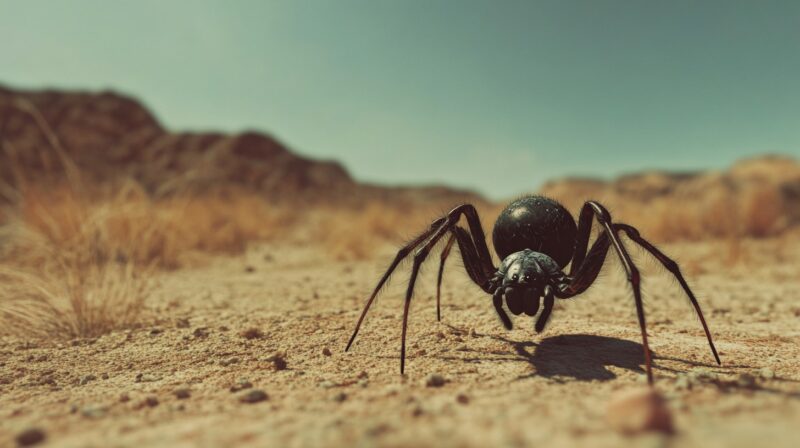
- Characteristics:
- Size: Small, with a red hourglass marking.
- Adaptation: Venomous bite.
- Diet: Insects.
The black widow spider is one of the most well-known venomous spiders, common in arid regions.
Recognized by its shiny black body and red hourglass marking, the black widow weaves strong webs to trap insects.
Its venomous bite is a defense mechanism and hunting tool, and it thrives in dry, secluded areas across Nevada’s deserts.
Summary
Contrary to popular opinion, deserts in Nevada have a plethora of wildlife. I experienced many of these desert animals myself.
That is why I can guarantee you that what you can see there is not like anything you have seen yet.
Related Posts:
- Why Stay at a 5-Star Resort When You Can Be in Laughlin?
- Where To Eat When You Come To Primm, Nevada?
- Why Should You Visit Primm in April? Sunny Days, Cool Nights
- How Many Numbers Do You Need To Win Lotto 47
- Don’t Worry, Laughlin Has Concerts… If You’re Really…
- Planning Your First Hiking Trip? Here’s Everything…

